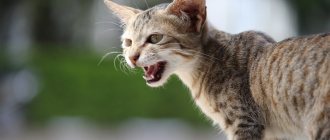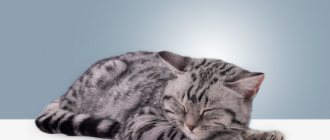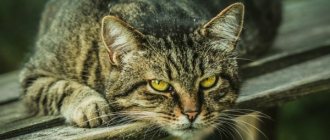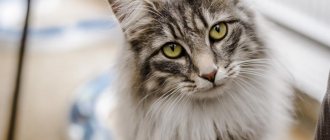Whiskered pets are the most famous warm-blooded dormouse. Their waking time is only 8-12 hours. For the rest of the day, they doze, curled up or stretched out like a sausage. Many of them snore, make funny sounds, move their mustaches and even move their paws.
All these sounds and movements confirm the presence of dreams, but what exactly cats dream about is a big mystery. There is quite a bit of research on this fascinating topic, but some questions have already been answered.
Length of cat sleep
The younger the pet, the longer he sleeps. Newborn kittens spend almost 23 hours a day in the kingdom of Morpheus. They only wake up to feed.
As you get older, your sleep duration gradually decreases. By 4-5 months, it is finally synchronized with the average, that is, 12-16 hours a day. The next change is observed only in old age, when the animal needs more time to restore its strength.
How long do cats sleep?
There is an opinion that clawed creatures sleep for two-thirds of their lives. Indeed: most of the time, owners see their cats lying in a cozy place with their eyes closed. However, the widespread statement is only partly true.
Taking a closer look at the pet, attentive owners may notice that the seemingly sleeping animal slightly moves its ears and moves its whiskers. If you touch your pet at such a moment, he will immediately meow or purr questioningly.
This behavior indicates that the cat was dozing without falling into deep sleep. Consequently, part of a cat's daily 14-hour rest period is spent dozing: it helps the animal rest while maintaining the ability to instantly react to its surroundings.
Experts note that real sleepyheads are rare, and the recorded record for sleep duration among pets is twenty hours a day.
Phases of falling asleep
Despite the surprisingly long duration of sleep, it cannot be said that all this time cats are completely immersed in the world of dreams. Most of the time they remain responsive to stimuli, which is easily confirmed by the frequent purring of a disturbed dormouse.
The activity of the brain and other important organs depends on the phase of falling asleep. Like people, there are only two of them:
- Fast or superficial. Essential for getting ready for bed. Lasts up to 15 minutes. When dozing, the animal is tense and sensitive to any noise. In case of danger, it will easily run away or attack the offender.
- Slow or deep. Accompanied by complete relaxation of the muscles and periodic twitching of the tip of the tail and whiskers. An animal awakened during this phase needs time to recover.
In humans, most of the dreams occur in the fast phase. They are also recorded in slow motion, but they are always shorter and less emotional.
Do cats dream in color?
Researchers are still arguing about this topic. In particular, many problematic issues related to human sleep have not been resolved. What can we say about a cat's sleep! Today, the prevailing point of view is that dreams in color are seen exclusively by emotional, expressive people.
As for cats, there is no consensus. Some scientists believe that cat dreams are woven from pictures in gray and blue tones. Others believe that yellow is added to these two colors. Be that as it may, color perception is significantly different between humans and cats due to differences in eye anatomy. Still, a human eye and a cat’s eye are not the same thing!
Perhaps those scientists who believe that cats have the most ordinary color dreams are also right. Only in slightly muted colors, not so bright. Where is the truth? We will find out over time, science does not stand still.
Do cats and kittens have dreams – and what kind?
The presence of dreams in the cat family was first proven by the French physiologist Michel Marcel Jouvet. During the experiment, he turned off one of the parts of the brain of a sleeping cat, which is responsible for muscle activity during sleep. After the blocking was removed, the subject showed a master class in hunting while in the fast phase. He completely ignored the real mice offered to him, chasing invisible prey, which served as proof of the presence of vivid images in his head.
What color are dreams?
To begin with, it is interesting to understand whether cats see colored dreams. Scientists do not have a consensus on this issue, but with a high probability, the pictures generated by the sleeping consciousness are no different from the real world. Unlike humans, mustachioed pets see humans only in the green and blue-violet spectrum. They are also available in various shades of gray.
Do cats dream about their owners?
The images that emerge during a dream often resonate with past experiences. Despite the lack of research on this topic, the likelihood of stories involving owners is very high, since they play one of the main roles in the life of their pet.
Do cats have food and household dreams?
All subsequent experiments with the removal of the block showed that the images in the subjects’ heads were associated with very strong emotions. Based on this, scientists have suggested that cat dreams reproduce events from the past that require increased concentration (hunting) and are accompanied by nervous tension (stressful situations).
In addition to memories, human dreams are divided into desires, associated with real experience, and fantasies, associated with the imagination. Mustached pets are characterized by both. Therefore, it is likely that, in addition to chasing mice and unpleasant trips to the veterinarian, they dream of their favorite treats, favorite toys and trips to the country.
Do cats have nightmares?
Having figured out whether cats dream, we can say with confidence that nightmares are not alien to them either. Unpleasant images are accompanied by various groans, nervous tail twitching, growling and hissing. After waking up from a nightmare, the mustachioed pet will easily scratch the first person he sees, or hide under the sofa in horror.
Cat's dream and human's
Let's start with the fact that a cat's sleep has the same cycles as a human's. Purrs also go through the so-called rapid eye movement (REM) sleep phase, during which we all dream - pleasant and not so pleasant. So it is quite logical to assume that cats dream. And they are fundamentally no different in content from ours: cats in their dreams experience what they recently saw, the events they witnessed. Hunting, playing, “socializing” with other cats and all that jazz.
In 1965, French scientists Jouvet and Delorme conducted a very interesting study, during which the so-called pons of the brain was removed from an experimental cat. After the operation, the animal was unable to lie still (well, or twitch a little) during sleep. On the contrary, in a state of sleep the cat walked, and even behaved aggressively! This discovery prompted the researchers to the right idea - in their sleep, cats rethink their experience. And they seem to be able to separate dreams from what they see in reality. Just like you and me.
Is anesthesia also a dream?
Owners who do not know all the nuances of anesthesia often wonder whether cats dream under anesthesia. The answer to this question is easy to obtain if you understand the essence of the procedure.
Anesthetics used during surgery depress vital signs. Because of this, anesthesia is more like an artificial fainting, and not like a dream. Instead of pleasant vigor, the awakened patient feels severe lethargy and weakness.
Sleep standards for domestic cats
Each cat’s sleep norm is different: not only does it depend on the individual characteristics of the animal, but also on the energy expended during the day. One day the animal may be very tired from a long walk on the street, and on another day it may lie for half a day looking out the window - therefore, the duration of sleepy hours on these days will be different.
The total time allotted for dreaming can vary from 14 to 22 hours. What does total time mean: the pussy does not sleep “from bell to bell”, but easily alternates periods of sleep and activity. The cat gets the missing time in the arms of the owner and in any cozy corner. Cats sleep lightly, so they are easily interrupted by any loud sound, and, as if nothing had happened, they remain awake for some time, in order to soon fall asleep again.
Sleep norms for newborn kittens are different - they constantly doze next to their mother, waking up only to feed. Gradually, their waking hours increase, but they sleep somewhat less than adults. Older cats relapse into childhood and dream again constantly, waking up to litter and feed.
How long do adult cats sleep?
global $ads_google;
//data-ad-slot=”2475549904″ $ads_google = empty($ads_google) ? false : true; ?> if ($ads_google == false) {?> $ads_google = true; ?> } ?> If you compare how much an adult cat and a tiny newborn kitten sleeps per day , the kids will win. But then the emphasis shifts - the older ones sleep for a long time, and the kittens spend a lot of time playing.
For a healthy, tired cat, it will not be a deviation from the norm if he sleeps 20 hours in one day: his body may require such a long hibernation.
If an adult animal, which is one of the record holders for sleep among mammals, suddenly sleeps little, it means that it is in a state of stress. If this problem continues, the cat may lose a lot of weight and become ill due to nervousness.
In general, a cat needs to sleep 12-14 hours a day, but the total amount of hours spent on this is sometimes difficult to determine precisely because of the frequent alternation of periods of dreaming and activity.
How long do kittens sleep?
A healthy kitten at a tender age will easily sleep 22 hours in one day. This is not a reason to worry, but a variant of the norm. Age plays a significant role: if newly born kittens immediately fall asleep after eating, then cats at the age of one or two months play for a long time next to their mother, study the world around them and are in no hurry to fall asleep. A mother cat often spends much more time sleeping than her curious children.
If an older kitten sleeps a lot, and in addition to this, he has poor appetite and low activity, then this is a reason to consult a veterinarian with suspected illness.
Should I wake my cat during a nightmare?
No, don't. Do not prevent the animal from living a normal, natural life. Dreams (even nightmares) are an integral part of the body’s life. As we know, cats dream in the REM phase. There is no need to interrupt this cycle, let it end in a “normal” way. There is a risk that your pet will become very scratchy, not to say aggressive, from such a sudden awakening!
So, dear cat lovers, your pets really do dream. Perhaps even colorful. Perhaps you too have some place in them. Just don’t try to extract anything from your cat: most likely, she will immediately refuse! It's better to leave it between us!
Source
What do cats dream about?
It is almost impossible to reliably determine the content of cat dreams, since there is no way to directly communicate with furry friends.
As Dr. Adrian R. Morrison of the Anatomy Laboratory at the School of Veterinary Medicine and the Institute of Neurological Sciences at the University of Pennsylvania, who led the study published in the Journal of Sleep Research, emphasizes, humans know almost nothing about what cats think, let alone what they dream about.
Since pets do not keep dream diaries, their owners will never know for sure what images, thoughts, sensations or reflections occur in the cat's mind during sleep.
Perhaps the cat is dreaming about her dinner, or she is chasing her favorite toy, or maybe she is dreaming about the one she loves most in the world - her owner.
Photo by John Brinn/CC BY 2.0
Photo nteee/CC BY-SA 2.0
Sleep phases of cats
People who have cats in the house can constantly observe how a seemingly soundly sleeping pet suddenly jumps up and rushes at maximum speed to the kitchen, to the owner or to the door. For cats that have become well-adapted to resting during light naps, waking up abruptly is normal. These animals constantly pick up information from everywhere, so there is nothing strange in such a rapid succession of states.
Cat dreams are divided into two phases, which replace each other:
- slow phase: decreased blood pressure, low muscle activity, decreased heart rate, slow breathing. The eyes under closed eyelids, at the moment of falling asleep, slowly move a little and then stop
- fast phase: rapid heartbeat, change in breathing rate, rapid rotation of the eyes, slightly increased blood pressure and body temperature, possible shudders, movement of the limbs and ears.
The fast phase in adult cats takes up to 25% of the total time, in old cats 15%. The slow phase lasts 20-30 minutes, and then it is replaced by a fast phase for 5-7 minutes. Over a long period of sleep, the phases alternate several times.











